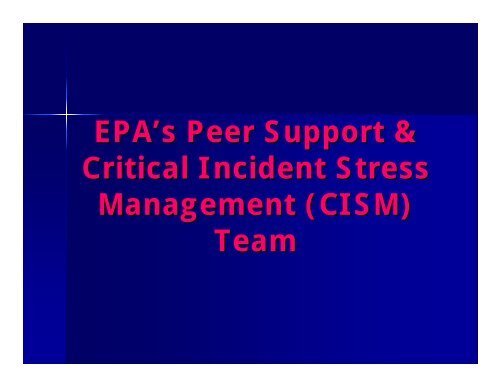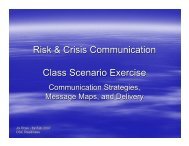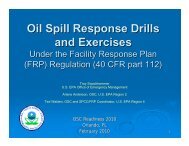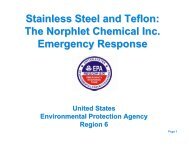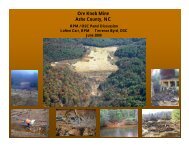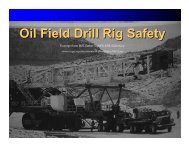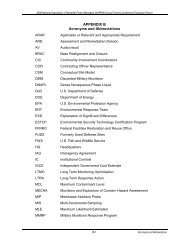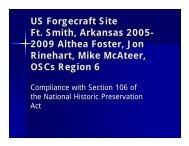EPA's Peer Support & Critical Incident Stress Management (CISM ...
EPA's Peer Support & Critical Incident Stress Management (CISM ...
EPA's Peer Support & Critical Incident Stress Management (CISM ...
- No tags were found...
You also want an ePaper? Increase the reach of your titles
YUMPU automatically turns print PDFs into web optimized ePapers that Google loves.
EPA’s s <strong>Peer</strong> <strong>Support</strong> &<strong>Critical</strong> <strong>Incident</strong> <strong>Stress</strong><strong>Management</strong> (<strong>CISM</strong>)Team
WHAT IS <strong>CISM</strong>?• <strong>CISM</strong> is a comprehensive,integrated, multi-componentcrisis intervention system thatincludes pre-incident preparation,individual crisis interventions,demobilizations, defusings,debriefings, follow-up referrals,and Animal Assisted CrisisResponse.
MISSION OF EPA’S S <strong>CISM</strong>TEAMTo provide support &assistance to EPA’s OSCsregarding day-toto-day stressexperienced in their jobs aswell as to OSCs and other EPAresponders during majoremergencies and disasters.
Why a <strong>Peer</strong> <strong>Support</strong>& <strong>CISM</strong> Team?• <strong>Stress</strong> management workshop,November 2000• Needs assessment• 9/11• Capitol Hill anthrax
About the Team• All volunteers; managerapproval required• Mixture of OSCs, , other staff,and mental healthprofessionals
CURRENT TEAMMEMBERSHIP• 27 team members, nationwide:Region 1 – 3 Region 2 – 4Region 3 – 2 Region 4 – 1Region 5 – 3 Region 6 – 2Region 7 – 2 Region 8 – 2Region 9 – 1 Region 10 – 1HQ – 4ATSDR -- 1ERT -- 1
Team Activations• <strong>Peer</strong> support component active 24/7as needed• First disaster mobilization: SpaceShuttle Columbia disaster; 12 teammembers rotated in and out on 1-week 1assignments• Second disaster mobilization:Hurricane Katrina; 2 rotations of 2team members into Mississippi &Alabama; 7 rotations of 14 teammembers into Louisiana
EPA’s s EmergencyResponders• On Scene Coordinators• Response <strong>Support</strong> Corps
On Scene Coordinators• EPA’s s principal emergencyresponders – 250 technicalexperts located in 10 Regionaloffices and out-post sites, whoassess the human health risks andenvironmental hazards fromspills, releases, natural disasters,industrial accidents, or terroristattacks
OSCs (continued)• Relatively young: 53% under age 39• Predominantly male (75%)• Educated: 95% college graduates; 44%with graduate degrees• 70% work out of a Regional Office; 30%out-posted• Experienced: 63% in their jobs for 7 yearsor longer; 27% more than 14 years• Personalities: independent, self-startersstarters
Traits of EmergencyResponders• Obsessive/Compulsive• Controlling• Action-Oriented• Easily Bored• Strong Need for ImmediateGratification• Duty Driven/Mission Oriented
Response <strong>Support</strong>Corps• Approximately 1,200 EPAemployees in the variousprogram offices at HQ and in theRegions• Available to deploy during majoremergencies & national disasters(e.g., Hurricane Katrina)
Where Do You FindEPA’s s Responders?
Train Derailments
Airplane Crashes
Oil Spills
Katrina
Clandestine Drug Labs
World Trade Center
Capitol Hill Decontamination
Space Shuttle ColumbiaRecovery Dive Unit
Abandoned Facilities
Fires
STRESS & STRESS REACTIONS• The physical and psychologicalprocess caused by viewing anevent as a threat and seeinglimited choices in dealing withthe threat.• Excessive stress arousal andunsuccessful coping strategiescan cause illness/dysfunctionin major body systems.
FACTS ABOUT STRESS• Inherent in survival• Necessary for human growth anddevelopment• Initially positive, but too much isunhealthy• Can affect physical health• It builds up• It’s s manageable
PSYCHOSOCIAL STRESSORS• Family relationships• Illness• Conflicts with management orcolleagues• Administrative hassles• Lack of appreciation• Abusive “customers”• Lack of support
PERSONALITY STRESSORS• Inability to say “no”• Need to be liked• Anxiety over competence• Negative outlook• Sensitivity to criticism• Extremely high expectations• Guilt over mistakes• Fear of making mistakes
• Alcohol• Drugs• DietBEHAVIORAL STRESSORS• Tobacco• Time management• Anger• Social withdrawal
COGNITIVE STRESS• Confused thinkingSYMPTOMS• Lowered concentration• Difficulty making decisions• Memory dysfunction• Decreased problem-solving ability• Decline in job performance
PHYSICAL STRESS SYMPTOMS• Excessive sweating• Dizzy spells• Increased heart rate/blood pressure• Rapid breathing• Fatigue• Headaches• Digestive problems• Insomnia• Sexual dysfunction
EMOTIONAL STRESSSYMPTOMS• Grief• Depression• Shock/anger• Frustration• Feeling overwhelmed• Fear/anxiety
BEHAVIORAL STRESSSYMPTOMS• Changes in ordinary patterns• Changes in eating habits• Decreased personal hygiene• Withdrawal from others• Prolonged silence/moodiness• Aggressive outbursts
Pre-Exposure Preparation• Remember:–Everyone has stress reactions–Reactions are NORMAL–Reactions must be dealt with–If you can’t t deal, they will dealwith you–There are effective ways to dealwith stress
PREVENTION TACTICS• Pre-incident education• Supervisor training to recognize stress• Recognize stress in others on responses• Teamwork• Exercise program• Talking with a peer, spouse, or friend• Spend time with family/friends
Hanging Out with Friends
Would You Be Interestedin Becoming a Member ofthe <strong>CISM</strong> Team?
Desired Team MemberQualities• Emotional maturity & sensitivity• Recognized for integrity &professional conduct• Ability to be discrete & maintainprivacy• Ability to work with others & as ateam member• Willingness to adhere toestablished procedures
If This Describes You &You Are InterestedContact Jan Shubert202-564564-2527Shubert.jan@epa.gov


